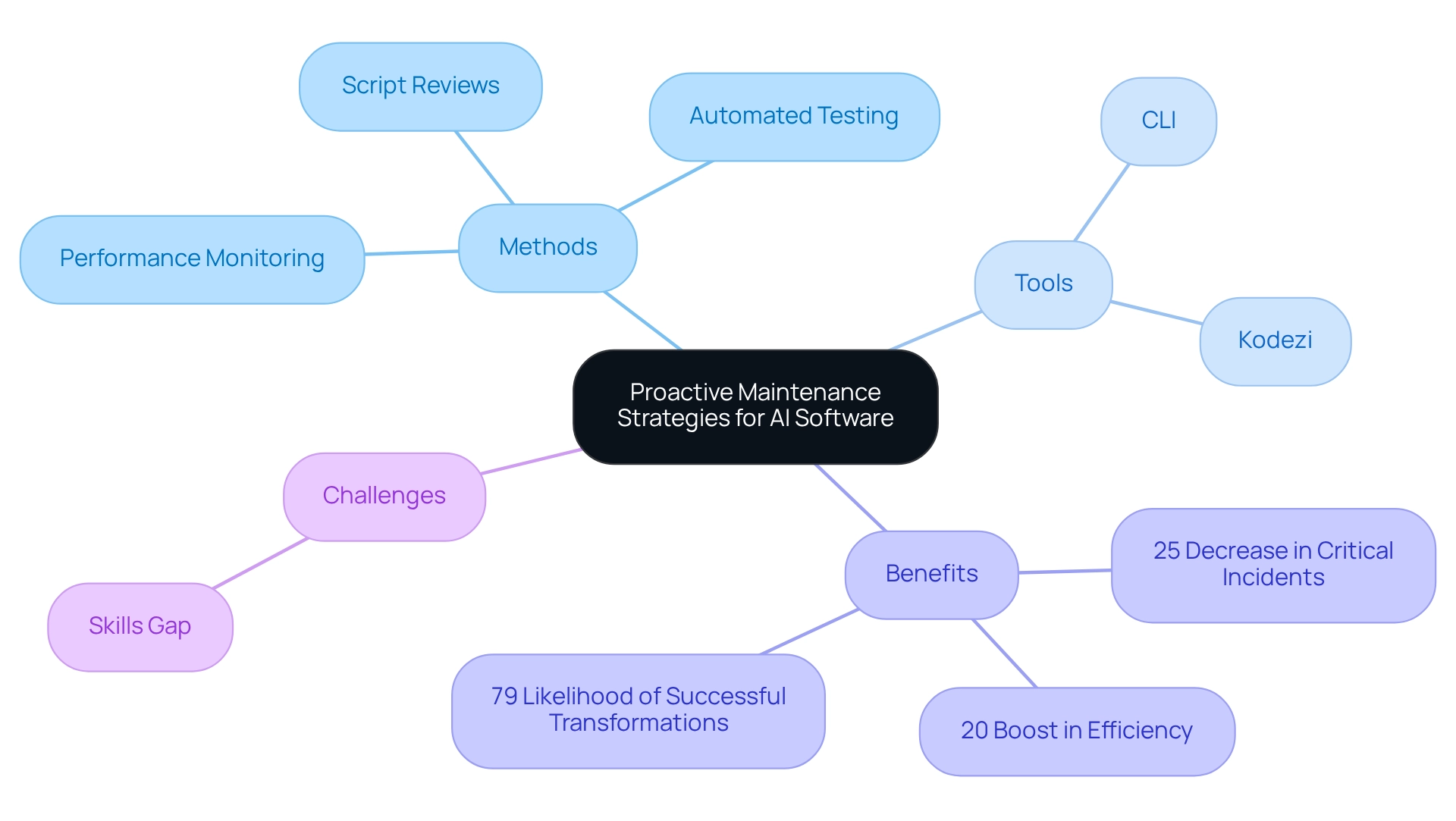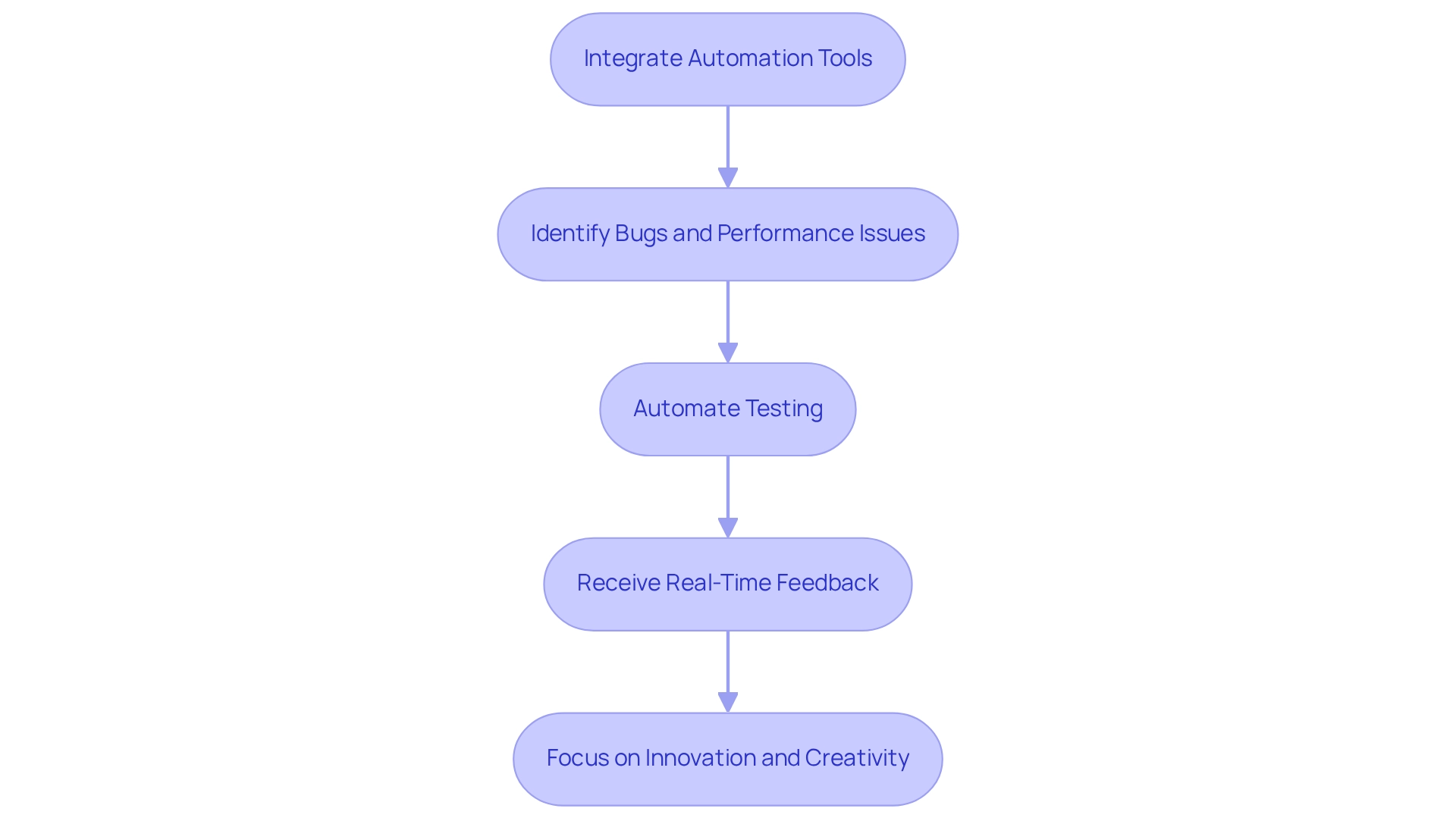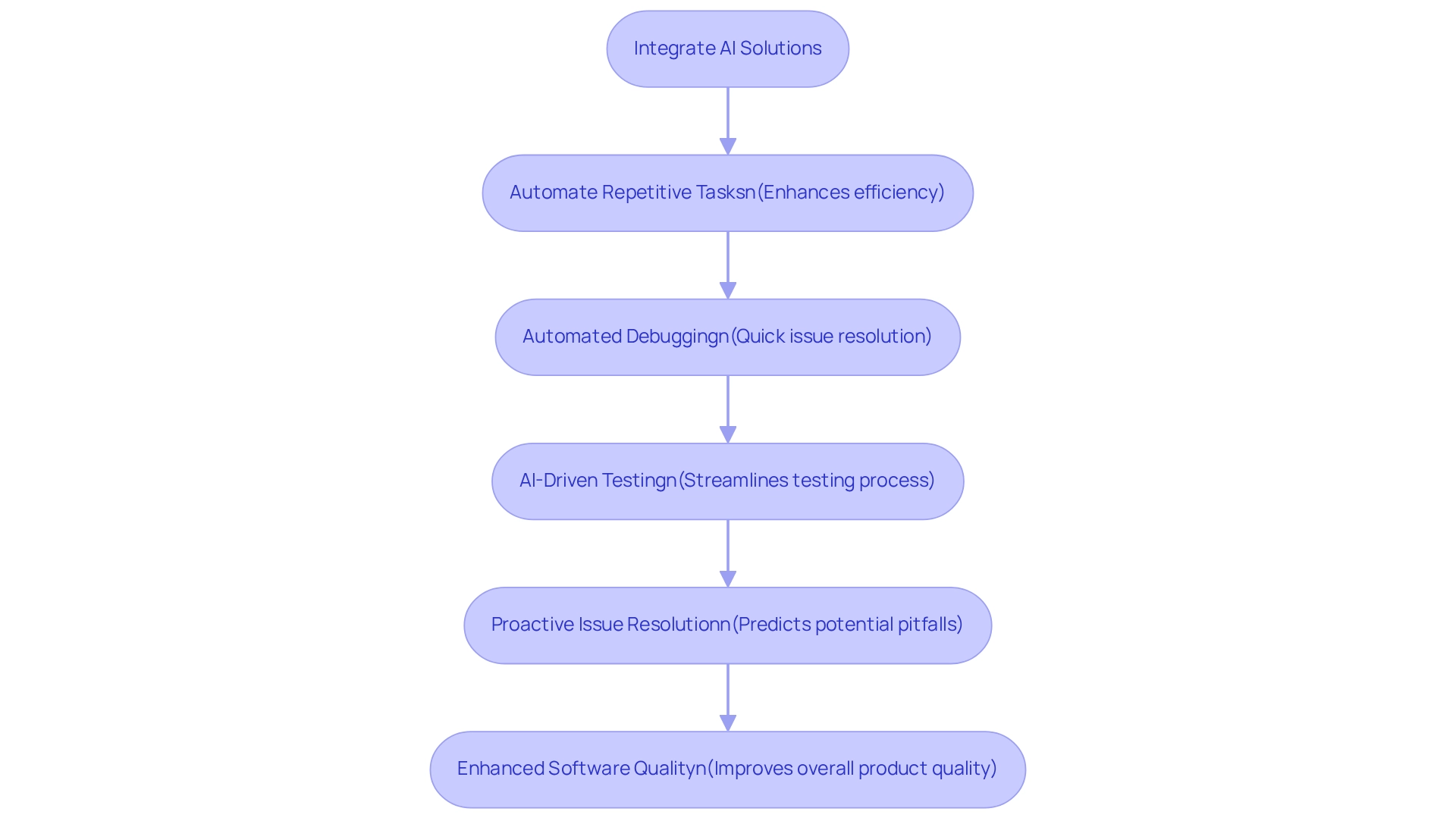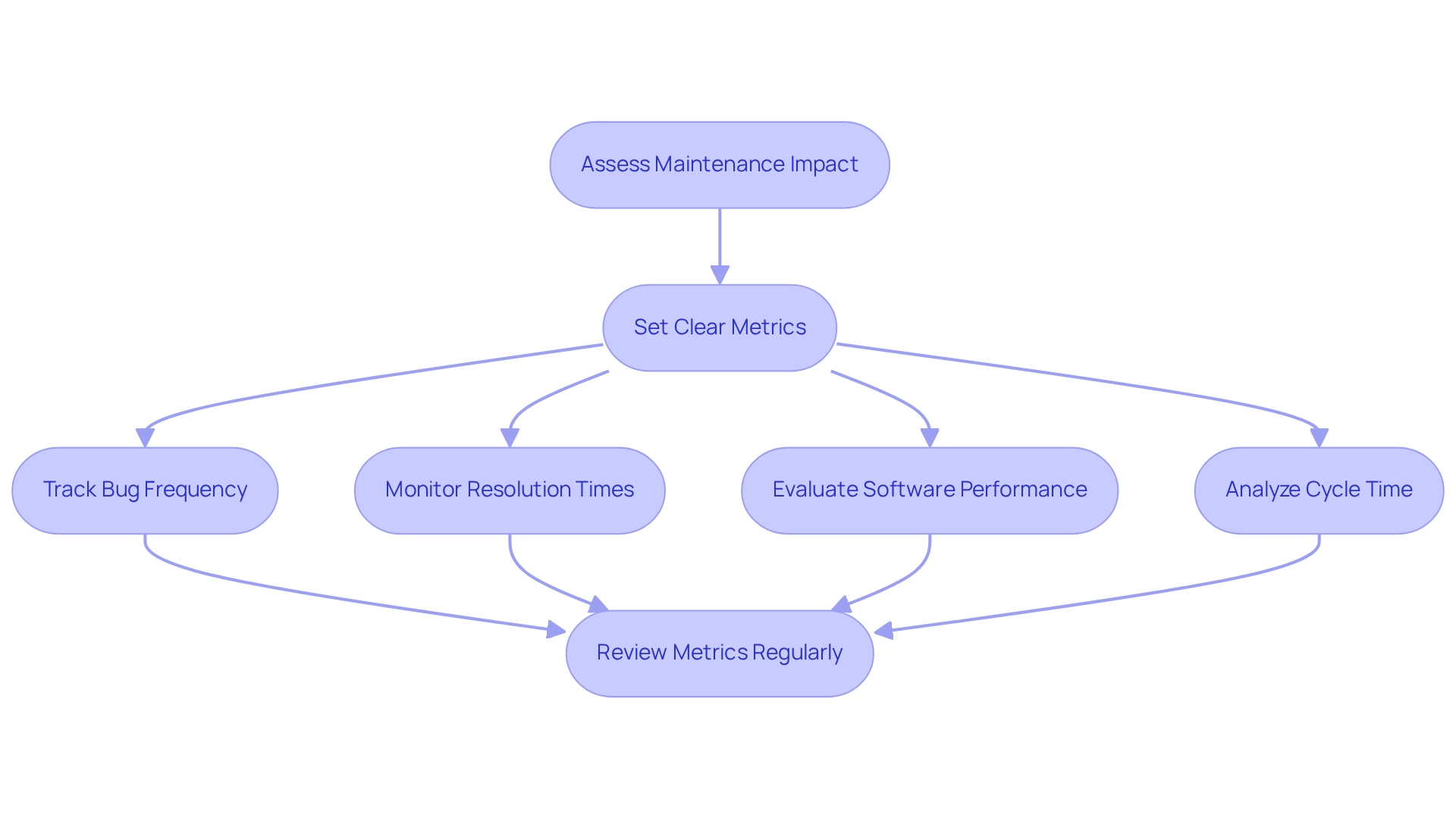Overview
Developers often encounter significant challenges in coding, particularly related to software maintenance. The article outlines four strategies for effective AI software maintenance that address these issues:
- Proactive maintenance
- Automation tools
- Integration of AI solutions
- Performance measurement
These strategies enhance software quality and reduce critical incidents, improving overall efficiency. By focusing on common challenges such as bug identification and code quality, they ensure a robust and reliable development process. Furthermore, implementing these strategies can lead to improved productivity and code quality, making them essential for developers looking to optimize their workflows. Explore the tools available to leverage these strategies and transform your software maintenance approach.
Introduction
In the rapidly evolving landscape of software development, developers face numerous coding challenges that can hinder application health and efficiency. How can organizations proactively address these issues before they escalate into costly problems? Enter Kodezi, a platform designed to tackle these challenges head-on. By integrating automation tools and AI solutions into development workflows, teams can enhance code quality, streamline processes, and significantly improve productivity. Furthermore, as these technologies advance, the ability to measure and analyze maintenance impacts will drive continuous improvement, ensuring that software not only meets but exceeds performance expectations. This article delves into the importance of these strategies and tools, highlighting how Kodezi can transform the development landscape for the better.
Adopt Proactive Maintenance Strategies for AI Software
Proactive maintenance is crucial for ensuring the health of your software, especially with AI software maintenance, by identifying and addressing potential issues before they escalate. Have you considered the challenges developers face in maintaining software quality? Methods such as reviews of scripts, automated testing, and performance monitoring are vital in the process of AI software maintenance.
For instance, regular evaluations of your software base can reveal areas of complexity or risk, allowing teams to restructure or enhance the system proactively. This approach can lead to a remarkable 25% decrease in critical incidents.
Furthermore, utilizing AI software maintenance tools such as CLI, which independently enhances programming quality, resolves errors, tackles performance issues, and guarantees security adherence before they reach production, can boost overall efficiency by up to 20%.
Kodezi's automated code debugging capabilities allow for rapid issue resolution, performance optimization, and security compliance. This not only helps maintain a clean and efficient codebase but also significantly enhances the software's longevity and reliability, with AI software maintenance strategies boosting the likelihood of successful transformations by up to 79%.
Are you aware of the challenges faced by maintenance teams, such as the skills gap that drives organizations to seek external resources? These factors further emphasize the necessity for proactive maintenance strategies in today's fast-paced development environment.
Explore the tools available on the Kodezi platform to enhance your coding practices and ensure your software remains robust and efficient.

Implement Automation Tools for Continuous Code Monitoring
Integrating automation tools into your development workflow can significantly enhance code monitoring. Developers often face challenges such as identifying bugs, maintaining performance, and ensuring security compliance. Tools like the CLI can independently identify and resolve these issues, revising unreliable tests and refreshing documentation as necessary.
Furthermore, by automating these processes, teams can focus on higher-level tasks while ensuring that their codebase remains clean and compliant. For instance, Kodezi’s AI-driven automated builds and testing improve quality and simplify CI/CD integration, offering real-time feedback on changes. This enables developers to address issues as they arise rather than after deployment.
In addition, the benefits of using Kodezi extend to improved productivity and reduced project completion times. Imagine the efficiency gains when teams can shift their focus from mundane tasks to innovation and creativity. By exploring the tools available on the Kodezi platform, developers can transform their workflow and enhance their coding practices.

Integrate AI Solutions into Development Workflows for Enhanced Efficiency
Developers often face significant challenges in coding, particularly regarding AI software maintenance, debugging, and maintaining code quality. Integrating AI solutions into development workflows can significantly enhance efficiency by automating repetitive tasks and delivering intelligent insights. Kodezi addresses these challenges with features like automated debugging, which enables programmers to quickly recognize and resolve issues in the codebase, offering comprehensive explanations of what occurred and how it was corrected.
This capability not only enhances code quality but also ensures compliance with the latest security best practices and coding standards through AI software maintenance. Organizations that embrace these tools for AI software maintenance can anticipate a significant enhancement in their software quality. A survey shows that 45% of highly efficient software groups utilize AI software maintenance extensively, linking AI adoption to improved group performance.
Furthermore, Kodezi's AI-driven testing frameworks can automatically generate and execute test cases, streamlining the testing process. By leveraging historical data from past projects, AI software maintenance can help predict potential pitfalls in new developments, enabling teams to proactively address issues before they escalate. This proactive strategy speeds up development cycles and strengthens the overall quality of the products created.
User testimonials further illustrate its impact, with over 1,000,000 users praising its ability to transform debugging and enhance productivity. For instance, a software engineer remarked, "I love what this platform is doing with debugging; it feels like I just unlocked a new superpower!" As we move towards 2025, it is projected that two-thirds of enterprises will integrate AI software maintenance into their workflows for tasks such as quality assurance and code reviews. Companies that strategically embrace AI software maintenance today, including those utilizing Kodezi, are poised to gain a competitive edge.
With market valuations of AI-centric firms expected to be approximately 60% higher than their non-AI counterparts, this trend highlights the essential role of AI in contemporary application development. Kodezi is an indispensable tool for teams aiming to uphold high standards of quality and efficiency in AI software maintenance. Explore the tools available on the Kodezi platform and elevate your development experience.

Measure and Analyze Maintenance Impact for Continuous Improvement
In the world of software development, ongoing enhancement in AI software maintenance is a significant challenge. How can developers effectively assess the impact of their maintenance activities? Setting clear metrics is essential. Key metrics include tracking bug frequency, resolution times, and overall software performance. Additionally, monitoring cycle time—the period from a change request to its production release—provides insights into the time-to-value versus efficiency ratio, guiding strategic decisions.
Enter Kodezi, a platform designed to tackle these challenges head-on. With its AI-driven automatic code correction and bug analysis, Kodezi enhances productivity across various programming languages and IDEs. The platform's analytics features simplify the visualization of these metrics, enabling teams to recognize trends and pinpoint areas needing attention. For instance, if a specific module consistently demonstrates high bug rates, Kodezi can identify issues and recommend optimizations, suggesting a need for refactoring or further testing.
Furthermore, real-time feedback from Kodezi's performance monitoring tools significantly enhances product quality and enriches the development experience. Regularly reviewing these metrics allows teams to adapt their strategies and improve their maintenance processes over time. Have you considered how a shift-left testing approach could enhance early issue identification? As industry analysts emphasize, this strategy ultimately leads to a more robust and responsive development process.
Recognizing and addressing technical debt is crucial as well. By doing so, you can make informed strategic decisions in AI software maintenance. Explore the tools available on Kodezi today, and empower your development team to achieve higher productivity and code quality.

Conclusion
Proactive maintenance strategies are essential for ensuring the long-term health and efficiency of software applications. By implementing techniques such as code reviews, automated testing, and performance monitoring, development teams can identify potential issues before they escalate into costly problems. The integration of tools like Kodezi streamlines these processes and enhances code quality and overall productivity. With capabilities that allow for autonomous debugging and optimization, Kodezi exemplifies how automation can transform the development landscape.
Furthermore, the adoption of AI solutions within development workflows is a game changer. By automating repetitive tasks and providing intelligent insights, Kodezi helps teams focus on higher-level objectives while maintaining a clean and compliant codebase. The evidence is clear: organizations leveraging AI tools report significant improvements in software quality and team performance, positioning themselves for competitive advantage in a rapidly evolving market.
Finally, the importance of measuring and analyzing the impact of maintenance activities cannot be overstated. Establishing clear metrics allows teams to continuously improve their processes, adapt strategies, and respond to emerging challenges effectively. Kodezi's analytics capabilities empower organizations to visualize their performance data, guiding informed decision-making and reinforcing the importance of a proactive approach to software development.
In conclusion, embracing proactive maintenance, automation, and AI solutions is not just beneficial; it is imperative for organizations aiming to thrive in the software development arena. By prioritizing these strategies, teams can ensure their applications remain robust, efficient, and ready to meet the demands of an ever-changing technological landscape.
Frequently Asked Questions
Why is proactive maintenance important for software, particularly AI software?
Proactive maintenance is crucial for ensuring the health of software by identifying and addressing potential issues before they escalate, thereby maintaining software quality.
What methods are essential for AI software maintenance?
Essential methods include reviews of scripts, automated testing, and performance monitoring, which help in maintaining software quality and identifying risks.
How can regular evaluations of software impact performance?
Regular evaluations can reveal areas of complexity or risk, allowing teams to proactively restructure or enhance the system, potentially leading to a 25% decrease in critical incidents.
What are AI software maintenance tools and how do they help?
AI software maintenance tools, such as CLI, enhance programming quality, resolve errors, tackle performance issues, and ensure security adherence before production, boosting overall efficiency by up to 20%.
What benefits does Kodezi offer for software maintenance?
Kodezi's automated code debugging capabilities allow for rapid issue resolution, performance optimization, and security compliance, maintaining a clean codebase and enhancing software longevity and reliability.
What is the impact of AI software maintenance strategies on successful transformations?
AI software maintenance strategies can boost the likelihood of successful transformations by up to 79%.
What challenges do maintenance teams face?
Maintenance teams often encounter challenges such as a skills gap, which drives organizations to seek external resources, highlighting the need for proactive maintenance strategies.
How can I explore tools for enhancing coding practices?
You can explore the tools available on the Kodezi platform to enhance your coding practices and ensure your software remains robust and efficient.




